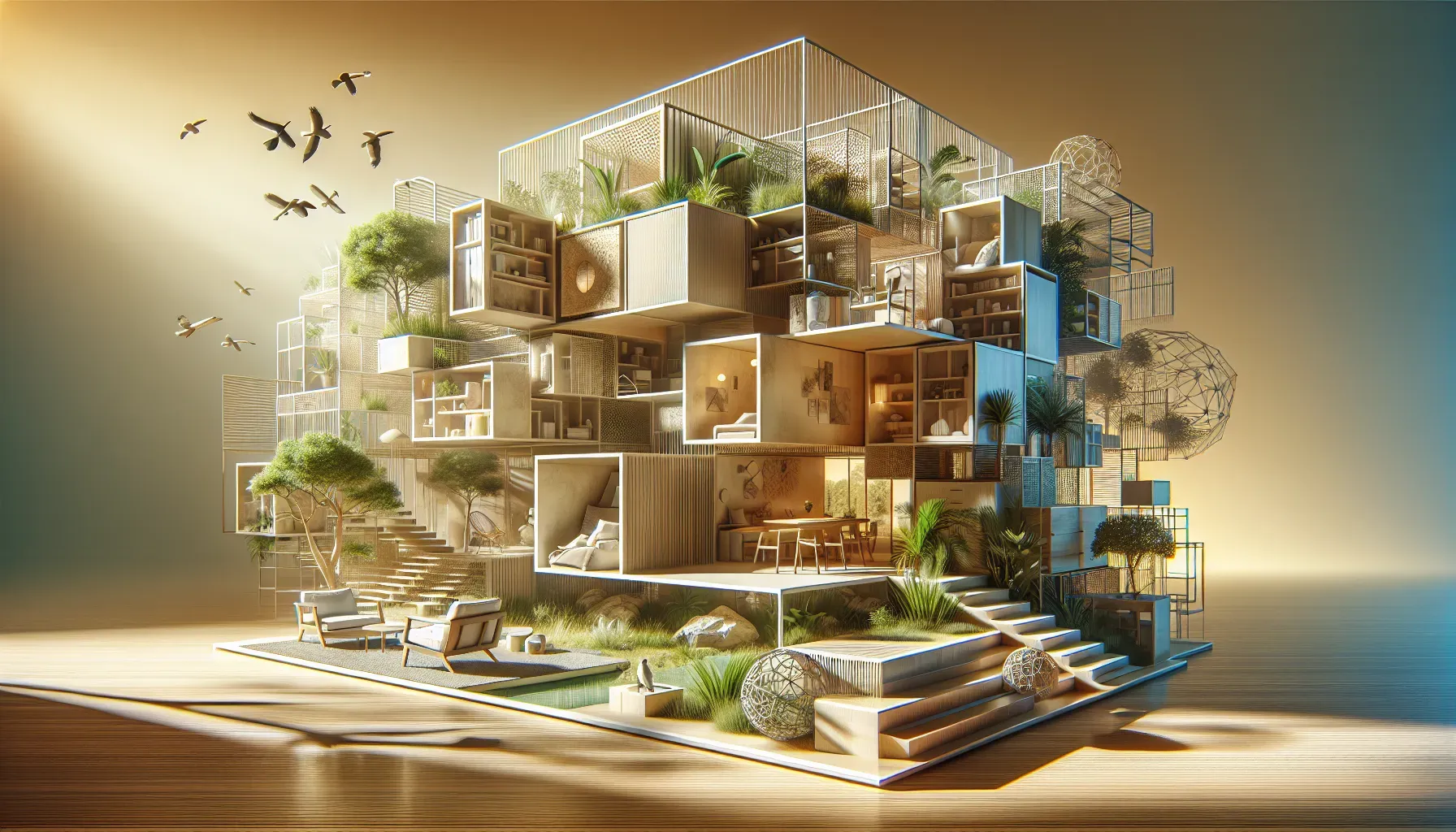Revolutionizing Spaces: The Transformative Influence of Wellness on Interior Design

In today's fast-paced world, the significance of integrating wellness into our living spaces has gained substantial traction. The concept is not merely about creating aesthetically pleasing interiors but also encompasses a holistic approach to design that prioritizes physical, emotional, and psychological well-being. Peppino's Health Haven acknowledges the vital connection between interior design and wellness, and in this article, we will delve into the multifaceted impact of wellness on interior design. From incorporating elements of nature for indoor health optimization to understanding the significance of color psychology and material choices, we will unravel the secrets to crafting spaces that promote overall well-being.
The importance of nature in promoting wellness has been widely documented. Biophilic design, which emphasizes the integration of natural elements into built environments, not only enhances the aesthetic appeal of spaces but also contributes to the well-being of its occupants. Incorporating natural elements such as indoor plants, natural textures, and organic materials can significantly improve air quality, reduce stress levels, and increase overall happiness.
Holistic Habitats: Nature's Role in Indoor Wellness
"When designing interiors with a focus on wellness, it's crucial to harness the innate connection between humans and nature. By bringing elements of the outdoors into interior spaces, we create environments that support physical health and mental equilibrium," says Mia Thompson, an interior designer with a specialization in wellness-focused spaces.
Minimalistic design principles align seamlessly with wellness-focused interiors. By decluttering living spaces and embracing simplicity, individuals can experience increased mental clarity and reduced feelings of anxiety. Minimalist interiors encourage mindfulness and intentionality in daily living, fostering a serene atmosphere that promotes relaxation and peace of mind.
Mindful Minimalism: Creating Calm and Clarity
"Mindful minimalism is not about stark emptiness; it's about curating spaces that prioritize what truly matters while eliminating distractions. This deliberate approach to design creates an environment where individuals can find solace and tranquility," notes Marco Rodriguez, an advocate for minimalist living.
Indoor air quality is a crucial determinant of overall wellness. Poor air quality can lead to a range of health issues, including allergies and respiratory problems. Hence, investing in innovative techniques for purifying indoor environments is paramount for creating healthy living spaces. This can involve integrating air purifying plants, utilizing advanced air filtration systems, and employing natural ventilation strategies.
"Improving indoor air quality goes beyond aesthetics; it directly impacts our health. When designing spaces with a wellness perspective, considering air purification techniques is non-negotiable," emphasizes Dr. Samuel Harper, an environmental scientist specializing in indoor air quality.
Related Article: The Healing Power of Nature: Embracing Ecotherapy for Well-Being
Air Quality Artistry: Techniques for Healthier Spaces
Natural light has a profound influence on our well-being. Spaces that are abundant in natural light not only reduce the reliance on artificial lighting but also contribute to improved mood and enhanced productivity. Designing spaces to maximize natural light exposure through strategically positioned windows, skylights, and light-reflective surfaces can uplift moods and alleviate feelings of depression.
"Natural light is a fundamental element for wellness-centric design. Its effects on circadian rhythms and vitamin D synthesis underscore its role in promoting emotional well-being and physiological health," explains Dr. Evelyn Foster, a researcher focusing on environmental psychology.
Lightening Up Lives: The Power of Natural Light
The furniture we incorporate into our living spaces plays a pivotal role in our physical well-being. Ergonomically designed furniture not only enhances comfort but also reduces the risk of musculoskeletal ailments. Prioritizing furniture that seamlessly merges aesthetics with physical support ensures that individuals can experience comfort without compromising on visual appeal.
"Incorporating ergonomic furniture into interiors reflects a commitment to holistic wellness. It enables individuals to engage with their surroundings without experiencing physical strain or discomfort," states Eric Patel, a furniture designer specializing in ergonomic solutions.
Related Article: The Science of Forest Bathing: Immersing in Nature for Mental & Physical Well-Being
Ergonomic Elegance: Furniture for Wellness and Comfort
Biophilic design principles emphasize the integration of natural elements not just for aesthetic value but also for instilling a sense of connectivity with the natural world. This approach seeks to create environments that resonate with our innate affinity for nature, thereby enhancing our overall well-being by reducing stress levels and supporting cognitive function.
"Biophilic design strives to create harmonious environments that nurture our innate biophilia - the affinity humans have for nature. By blurring the boundaries between indoor and outdoor spaces, we craft settings that invite tranquility and restoration," highlights Sofia Lee, an architect specializing in biophilic design principles.
The influence of colors on human psychology is profound and well-documented. When designing interiors with a focus on wellness, selecting color palettes that evoke psychological harmony is pivotal. Calming hues such as soft blues and gentle greens can induce relaxation, while vibrant tones like sunny yellows can infuse spaces with energy and positivity.
Biophilic Design Demystified: Connecting with Nature
"Color psychology offers a powerful tool for creating atmospheres that cater to diverse emotional needs. Understanding how colors influence mood allows us to craft living spaces that support emotional balance and well-being," asserts Rebecca Carter, an interior decorator specializing in color psychology applications.
The materials used in interior design can significantly impact indoor air quality and overall health. Opting for non-toxic materials such as VOC-free paints, formaldehyde-free furnishings, and sustainable flooring options contributes to creating healthier home environments while minimizing exposure to harmful chemicals.
Color Psychology in Practice: Choosing Calming Palettes
"Material choices play a pivotal role in shaping the health outcomes of occupants within designed spaces. Prioritizing non-toxic materials aligns with the ethos of creating interiors that safeguard both human health and environmental well-being," emphasizes Dr. Lucas Wright, an expert in sustainable building materials.
In conclusion, the fusion of wellness principles with interior design not only elevates the aesthetic appeal of spaces but also nurtures environments that support holistic well-being. From biophilic design concepts to mindful material selections, every aspect of interior design presents an opportunity to cultivate spaces that prioritize physical health, emotional equilibrium, and psychological harmony.
As individuals continue to recognize the intimate link between their surroundings and well-being, embracing wellness-focused interior design becomes paramount for fostering healthier lifestyles within homes and communal spaces alike. Peppino's Health Haven remains committed to championing this transformative approach to interior design as it continues to redefine environments into sanctuaries that promote vitality and overall wellness.
Frequently Asked Questions
Biophilic design integrates natural elements into built environments, enhancing aesthetics and promoting occupant well-being. By incorporating features like indoor plants and natural textures, it improves air quality, reduces stress, and fosters a connection with nature, ultimately supporting physical and mental health.
Improving indoor air quality can be achieved by using air-purifying plants, advanced filtration systems, and ensuring proper ventilation. These methods help reduce allergens and pollutants, creating a healthier living environment that supports overall wellness and minimizes respiratory issues.
Natural light significantly impacts emotional and physical well-being. It enhances mood, boosts productivity, and regulates circadian rhythms. Strategically positioning windows and using light-reflective surfaces can maximize natural light exposure, creating uplifting spaces that contribute to a healthier lifestyle.
Minimalist design promotes mental clarity by reducing clutter and distractions. This intentional approach fosters a serene atmosphere that encourages mindfulness, relaxation, and peace of mind. By focusing on essential elements, individuals can create spaces that support emotional well-being.
Color psychology plays a crucial role in interior design by affecting emotions and moods. Calming colors like soft blues promote relaxation, while vibrant hues like yellows can energize a space. Understanding these effects helps create environments that cater to various emotional needs.
Selecting non-toxic materials is essential for creating a healthier home. Opt for VOC-free paints, formaldehyde-free furnishings, and sustainable flooring options to minimize exposure to harmful chemicals. These choices contribute to improved indoor air quality and overall well-being for occupants.
Wellness-focused interior design benefits everyone, including families, individuals working from home, and communities. By creating spaces that prioritize physical health, emotional balance, and psychological harmony, these designs foster healthier lifestyles and enhance the quality of life for all occupants.
Yes, ergonomic furniture is designed to enhance comfort and support physical well-being. It reduces the risk of musculoskeletal issues by promoting proper posture. Incorporating such furniture into your living space allows you to enjoy aesthetic appeal without compromising on health benefits.
You can create a connection between your living space and nature by incorporating biophilic design elements such as indoor plants, natural materials, and views of the outdoors. This approach nurtures an affinity for nature, reducing stress levels while enhancing cognitive function.
Check Out These Related Articles

Code Green: Unwrapping the Consequences of Environmental Packaging Laws for Wellness Brands

Sustainable Wellness Practices: Analyzing the Environmental Impact of Holistic Health Choices

Biophilic Design in Healthcare: Optimizing Healing Environments with Nature-Inspired Spaces
